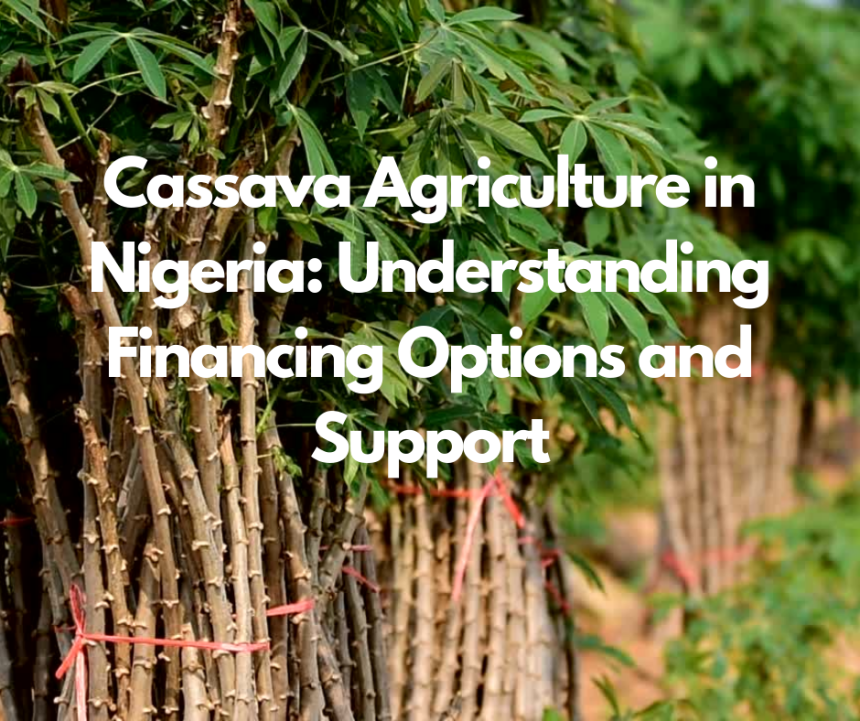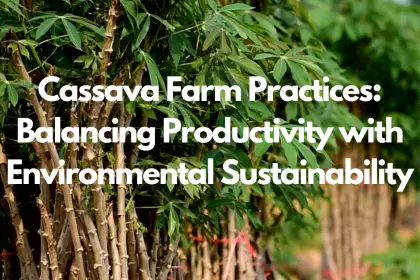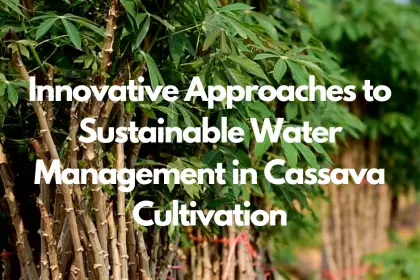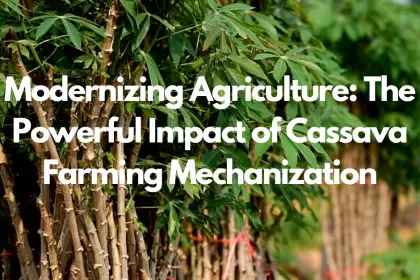Nigeria holds the title as the world’s largest producer of cassava, an essential crop that not only serves as a significant source of dietary starch but is rich in vitamin C and protein. This tuberous root, primarily cultivated by small-scale farmers, is crucial for human consumption and represents a vital cash crop for households. While cassava farming is fundamental to Nigeria’s agricultural landscape, it faces challenges, including the need for improved practices and mechanization to boost production and sustainability.
Exploring financing options and support for cassava agriculture in Nigeria reveals a complex ecosystem involving government interventions, private equity, and technical assistance. This article aims to delve into the array of financing schemes and support mechanisms available to cassava producers. By highlighting the roles of both governmental and non-governmental entities in enhancing cassava agriculture, this piece seeks to provide insights into how to overcome hurdles and seize opportunities within this sector, benefiting the countless households reliant on cassava for both nutrition and income.
Overview of Nigeria’s Cassava Production
Nigeria’s prominence as the world’s largest cassava producer is underscored by its contribution of approximately 26% to global production. This achievement is highlighted by the significant production volumes over the years, with a record of over 63 million tons in 2021 alone. The trajectory of cassava production in Nigeria has seen a steady increase since 1970, peaking at 59.5 million tonnes in 2018. However, the average yield per hectare has experienced fluctuations, with a noted decline in the Compound Growth Rate (CGR) of -0.2% during the period from 1970 to 2018.
- Production Dynamics:
-
- Increase in Output: Largely attributed to the expansion of harvested areas by 152%.
- Yield and Area Interaction: Led to a decline in production output by 45.8%.
- Harvested Area Instability: Indicated by an instability index of 11.8, suggesting significant fluctuations in cassava production.
To address these challenges and capitalize on the opportunities within the cassava sector, a multifaceted approach is recommended. Prioritizing the planting of high-yield cassava stems over merely expanding the cropped area could significantly enhance production sustainability. Additionally, the 2022 data reveals a production volume of 60,835,539.96 tonnes from a cultivation area of 10,029,844 Ha, emphasizing the critical need for strategic interventions to bridge the supply-demand gap for cassava by-products. The gap for High-Quality Cassava Flour stands at approximately 485,000 metric tonnes annually, and for cassava starch, about 290,000 metric tonnes. Meeting these demands necessitates the planting of approximately 28.3 million metric tonnes of fresh cassava root annually, requiring around 1.2 million hectares of land.
- Strategic Interventions:
-
- High-Quality Cassava Flour: Supply-demand gap of approximately 485,000 metric tonnes per annum.
- Cassava Starch: Gap of about 290,000 metric tonnes.
- Annual Planting Requirement: Approximately 28.3 million metric tonnes of fresh cassava root, requiring around 1.2 million hectares of land.
In conclusion, addressing the challenges of low yields, poor handling, and unorganized market structure, coupled with strategic investments in farmers’ training, modern processing facilities, and mechanization, can significantly enhance the quality and competitiveness of Nigeria’s cassava products on the global stage.
Governmental and Institutional Financing Schemes
In response to the diversification of Nigeria’s economy and the reduction of reliance on oil, several governmental and institutional financing schemes have been established to support cassava production and agricultural development more broadly. These initiatives aim to enhance national food security, reduce the cost of credit in agricultural production, and stimulate economic growth through increased output and employment.
- Key Financing Schemes:
-
- Agricultural Credit Guarantee Scheme Fund (ACGSF): Established in 1977, it guarantees up to 75% of credit facilities extended to farmers by banks, with the Federal Government and the Central Bank of Nigeria holding 60% and 40% of the shares, respectively.
- Agricultural Credit Support Scheme (ACSS): Offers loans at a single-digit interest rate of 8.0 percent to enable farmers to exploit the untapped potentials of Nigeria’s agricultural sector.
- Commercial Agriculture Credit Scheme (CACS): Introduced in 2009 and financed through a N200 billion Bond, it disburses loans at a maximum interest of 9 percent to eligible entities to fast-track agricultural development.
These schemes have had a tangible impact on the agricultural sector, with the CACS disbursing N147.87 billion to 191 businesses between 2009 and 2016, predominantly in crop production, livestock production, and agricultural produce processing. The majority of funds were directed towards activities that recorded positive growth in income and volume of produce. Additionally, efforts from non-governmental organizations and international grants, such as the $2,000,000 from the Rockefeller Foundation to IDH for the cassava industry, complement these governmental initiatives by providing access to investment capital and technical assistance. These combined efforts aim to create a structured market and enhance the sustainability of cassava production in Nigeria.
Private Equity and Investment Funds
Cassava production in Nigeria not only fulfills local consumption needs but also holds a significant export potential, particularly to markets in Europe and Asia. The cultivation and processing of cassava into value-added products such as flour, starch, chips, ethanol, and animal feed can unlock substantial economic benefits. This shift towards industrialization and diversification of cassava products necessitates substantial investments in modern processing technologies and infrastructure to improve quality, diversity, and marketability. Automated drying equipment and mechanized peeling and chipping machines represent examples of contemporary technologies that can enhance productivity and reduce post-harvest losses.
Private equity and investment funds have recognized the lucrative opportunities within Nigeria’s cassava sector. For instance, Sahel Capital and CardinalStone Capital Advisers (CCA) have made significant investments in Crest Agro Products, a leading integrated cassava processor in Kogi State. This investment supports the establishment of a starch processing facility and the expansion of farming activities. Crest Agro Products, with its extensive farming operation and outgrower scheme involving over 400 smallholder farmers, is positioned to become a market leader in the region. The investment aligns with the strategies of both investors to support import substitution and impact smallholder farmers positively.
Furthermore, a Nigerian private investment group is planning a large-scale commercial cassava project aimed at starch and derivatives production. Covering an area of 10,000 hectares, the project includes high-standard farming equipment for mechanization and an out-growers scheme to integrate the local population. This initiative is designed for a quick return on investment, demonstrating the attractiveness of cassava production to private investors. The involvement of experts in large-scale farm development, agro-economics, and project design underscores the project’s comprehensive approach to enhancing the cassava value chain in Nigeria.
Technical Assistance and Capacity Building
In addressing the critical need for technical assistance and capacity building within Nigeria’s cassava sector, several strategic approaches have been identified:
- Rapid Development and Dissemination of Improved Varieties:
-
- Development, multiplication, and widespread dissemination of improved cassava varieties.
- Enhanced availability and diversity of improved planting materials, targeting both yield and disease resistance.
- Research and Development Funding:
-
- Adequate and sustained research funding is pivotal.
- Essential areas include long-term core research funding, adaptation of harvesting or peeling machines for smallholder use, and initiation of cassava breeding and engineering research.
- Value Addition and Supply Chain Enhancement:
-
- Shift towards value addition and product innovation in Nigeria’s cassava processing industry.
- Development of robust supply chain infrastructure, including cold chain logistics, transportation networks, and storage facilities, to mitigate post-harvest losses.
These strategic interventions are designed to address the multifaceted challenges of cassava production, from the field to the market. By focusing on improved cassava varieties, adequate research funding, and enhanced supply chain infrastructure, stakeholders aim to boost productivity, reduce losses, and ensure sustainable growth in the cassava sector.
Challenges and Opportunities in Financing Cassava Production
In the realm of cassava production in Nigeria, financing plays a pivotal role in addressing both the challenges and leveraging the opportunities that exist within this sector. The emphasis on increased food production, including cassava, is not just about enhancing national development and GDP growth; it also carries the potential to significantly reduce poverty and unemployment rates through special interest loans for agricultural inputs. Moreover, the success stories from Indonesia and Angola demonstrate the lucrative revenue that can be generated from increased cassava processing.
However, several constraints hamper the growth of the cassava subsector in Nigeria. These include:
- Access to Capital: A major limitation, with a significant portion of farmers having limited access to rural credit.
- Production Challenges: Pests and diseases, agronomic problems, and a shortage of planting materials.
- Market and Policy Issues: Poor market access, inconsistent policy measures, and limited diversification of processing options.
- Technological Gaps: Inadequate access to improved processing technology and inefficient extension delivery systems.
To overcome these hurdles and tap into the sector’s full potential, strategic interventions are necessary:
- Promotion of Industrial Uses: Encouraging the diversification of processing options to enhance rural household income.
- Intensive Planting Practices: Adopting high-yield cassava stems rather than solely expanding cropped areas.
- Technological Innovations: Developing labor-saving technologies for smallholder cassava harvesting and meeting quality standards to foster strong trade relationships, thereby increasing export earnings.
Addressing these challenges through targeted financing options and support mechanisms can pave the way for a more robust and sustainable cassava production landscape in Nigeria, benefiting not only the farmers but also the nation’s economy at large.
Conclusion
As we navigate through the pivotal role of cassava agriculture in Nigeria’s economy, it becomes evident that a concerted effort involving government, private investors, and technical support is crucial for harnessing the full potential of this invaluable crop. The exploration into financing options, capacity building, and market expansion underscores the myriad opportunities and challenges within the sector. By highlighting the strategic imperative of modernizing agricultural practices, enhancing processing capacities, and facilitating access to capital, this article illuminates the path forward for stakeholders at every level of the cassava value chain.
The journey toward revitalizing Nigeria’s cassava sector is paved with the promise of greater economic diversification, food security, and rural development. Emphasizing the need for strategic investment and policy support, as demonstrated through various financing schemes and technical assistance programs, sets a framework for sustainable growth. Together, these efforts can drive a significant transformation in how cassava is cultivated, processed, and marketed, marking a new chapter in Nigeria’s agricultural narrative that benefits not just the local economy but also sets a benchmark for agricultural innovation globally.
FAQs
What is the estimated cost to establish a cassava processing facility in Nigeria?
To set up a cassava processing plant in Nigeria, the initial fixed capital required is approximately N26,600,000, which covers the cost of the factory building, machinery and equipment, a generator, a project vehicle, office furniture and equipment, and a borehole. Additionally, you should expect to need around N5,600,000 for initial working capital and about N2,600,000 for pre-production expenses.
Can you explain the demand versus supply situation for cassava in Nigeria?
In Nigeria, there is a high domestic demand for cassava and its by-products. Nevertheless, the current supply falls short of fulfilling this substantial demand. Specifically, there is an annual supply-demand gap of approximately 485,000 metric tonnes for High-Quality Cassava Flour and about 290,000 metric tonnes for cassava starch.
What are the primary obstacles faced in cassava agriculture in Nigeria?
Cassava production in Nigeria faces several challenges, including the agricultural policy framework, the extent of mechanization, the state of infrastructure, the availability of agricultural technical experts, and the ease of access to capital. These factors significantly impact the efficiency and success of cassava processing in the country.
How significant is cassava farming to Nigeria’s economy?
Cassava farming holds great economic significance in Nigeria. It serves as a crucial food crop and is even more vital as a source of cash income for many households. In terms of generating cash flow, cassava stands out among other staple crops, playing a significant role in poverty reduction and contributing to the economic well-being of a large number of families.









